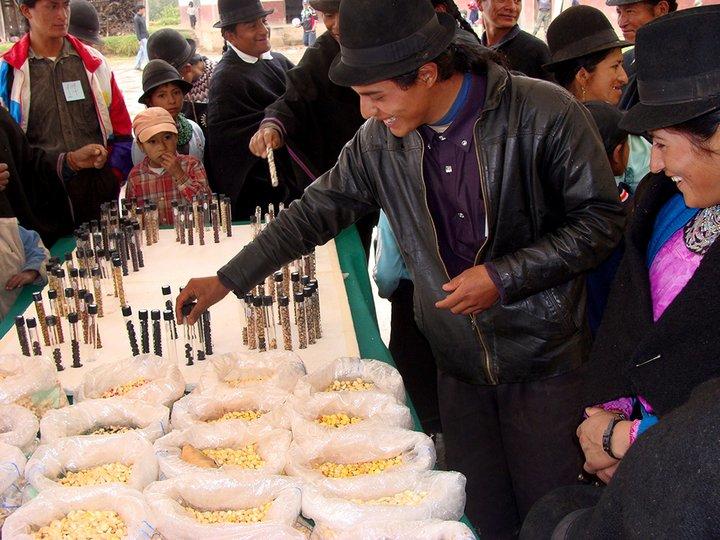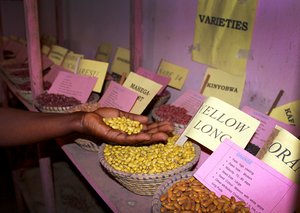Blog A fresh look at crop seeds for healthy diets

As we get ready for World Food Day, researcher Jacob van Etten reminds us that seeds are a central piece of our food systems, as the vehicles that deliver the benefits of agricultural biodiversity: environmental sustainability and healthy diets.
In a new blog, Bioversity International scientist Jacob van Etten reminds us that seeds are a central piece of our food systems, as the vehicles that deliver the benefits of agricultural biodiversity: environmental sustainability and healthy diets. The blog highlights the main issues discussed in Chapter 4 of 'Mainstreaming Agrobiodiversity in Sustainable Food Systems', a new Bioversity International book that provides solid evidence that investments in agricultural biodiversity play a critical yet overlooked role in tackling global targets such as reducing poverty and malnutrition, reversing environmental degradation and combatting climate change. The book will be presented on 11 October 2017 at the 44th Committee on World Food Security in Rome, Italy.
By Jacob van Etten
Almost a year has passed now since Hurricane Otto devastated Nicaragua. Houses and roads have been fixed and, on the surface of things, lives have returned to normal. But if you look in the kitchen gardens and at the food provided on the table, you can see quite a different story.
Many kitchen gardens are empty. The heavy rains damaged the vegetables, making it impossible to extract the seeds to plant for this year. Farmers have been able to get some maize and bean seeds, but vegetable seeds are hard to find. With the market four hours away, vegetables are hard to come by and difficult to find fresh.
 Availability of seeds directly affects if these families can put healthy food on the table for their children. When seeds go missing, it becomes very clear that they cannot be taken for granted.
Availability of seeds directly affects if these families can put healthy food on the table for their children. When seeds go missing, it becomes very clear that they cannot be taken for granted.
Agricultural scientists are starting to realize the importance of seeds for human nutrition. Over the last decades, crop breeding mainly focused on the yield of staple crops that provide the bulk of calories. But the narrow focus on improving yields has reduced the nutrient content of these crops. Other crops that contain essential nutrients, such as vegetables, have received much less attention from crop breeders.
Government bean breeders, together with Zamorano, a university based in neighbouring Honduras, have developed a range of new varieties of beans. But not all farmers benefit from this investment in seeds. Studies have found over and over again that small-scale farmers find it difficult to get crop seeds that do well on their farm and result in a good product. The range is limited, and varieties may not have the characteristics that farmers would like – for example drought tolerance.
Farmers often take a bet when they buy seeds. They do not know if they will germinate and grow into a healthy crop. Governments try to regulate seed sales to protect farmers who buy seeds. But the rules are rarely written with small-scale farmers in mind. Instead, seed laws often create red tape for quality seeds that are affordable and available in rural areas.
 Until recently, the benefits of seeds were measured in terms of the number of new modern varieties that had been developed and how many tonnes of seeds of these varieties were distributed. Fortunately, a different perspective on seeds, centred on farmers and consumers and the benefits of agricultural biodiversity, is taking shape among agricultural scientists and policymakers. Seeds are increasingly seen as a central piece of the wider food system, as the vehicles that deliver the benefits of agricultural biodiversity: environmental sustainability and healthy diets. Investments are directed at decentralized, low-cost seed innovation and delivery systems that benefit rural families, such as community seedbanks.
Until recently, the benefits of seeds were measured in terms of the number of new modern varieties that had been developed and how many tonnes of seeds of these varieties were distributed. Fortunately, a different perspective on seeds, centred on farmers and consumers and the benefits of agricultural biodiversity, is taking shape among agricultural scientists and policymakers. Seeds are increasingly seen as a central piece of the wider food system, as the vehicles that deliver the benefits of agricultural biodiversity: environmental sustainability and healthy diets. Investments are directed at decentralized, low-cost seed innovation and delivery systems that benefit rural families, such as community seedbanks.
Policymakers need to know how well their country is doing in this regard. Therefore, a fresh look is needed on how to assess the current status and to set priorities for new policies and investment.
An in-depth, but highly readable, review on the available evidence and practical implications of this new perspective on seeds is now available in Chapter 4 of a new publication by Bioversity International – Mainstreaming Agrobiodiversity in Sustainable Food System.
Download Chapter 4 ‘The contribution of seed systems to crop and tree diversity in sustainable food systems’
Download the full book Mainstreaming Agrobiodiversity in Sustainable Food System
_______________
Photos (from top to bottom):
1. Farmers learn about different bean and maize varieties at a seed fair in Saraguro, Ecuador. Credit: Bioversity International/J.Coronel
2. Diversity of vegetables and herbs produced in home gardens, Nepal. Credit: LI-BIRD/A.Subedi
3. Bean varieties in a community seedbank in Kiziba, Uganda. Credit: Bioversity International/A.Sidhu
